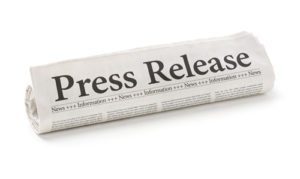It is an undeniable fact that media exerts an enormous amount of power and influence over businesses. Good PR is capable of harnessing this power, and it is a cost effective way of getting your company noticed.
 The secret to superior PR is the planning and thought that goes into it – using effective strategies to gain maximum company exposure. If you can create a successful PR campaign, then your business will receive a tremendous amount of publicity and credibility for a relatively small outlay.
The secret to superior PR is the planning and thought that goes into it – using effective strategies to gain maximum company exposure. If you can create a successful PR campaign, then your business will receive a tremendous amount of publicity and credibility for a relatively small outlay.
In the following post we will talk through how to layout, structure and write a press release to help you generate more exposure.
Writing a press release
To write your press release, there are several element of their layout should remain uniform:
News release and date
On the top left hand side, type ‘News Release’ alongside the date that you are sending it out. Further along the line, ‘For Immediate Release’ should also be written. This top line may be underlined and possibly highlighted in a different colour- our personal preference is red, but this is up to you.
Make sure that the date on your release is the day that you are sending out the release.
Headline
Next, skip a line and use a boldface type for your headline. The headline is vital, this is what first catches the editor’s attention – because of this, it is recommended to be written last of all. Doing so will put you in a position to summarise the story with pinpoint accuracy.
Lead Paragraph
The first paragraph needs to grasp the reader’s attention therefore you should consider it very carefully. It should contain the relevant information to your message, such as the five W’s (who, what, when, where, why); summarising what the rest of the release is about.
Spend plenty of time crafting the first 10 words of your release- they must make an impact straight away. Because editors receive so many releases, it is essential that your first sentence grabs their attention. Investing half of your time writing the first sentence and headline is worthwhile. Try to think about what is interesting about your story – why would people in the local area/trade etc. want to read about it?
Main body
The main body of your press release is where your message should fully develop.
Throughout the press release you should always keep emotive language to a minimum. Remember, you are not writing an advert: your release should be written in an objective, unsensational style. You are recounting the facts and should therefore aim for an impersonal written style, avoiding adjectives as much as possible.
Don’t be tempted to deter from facts and embellish a release with fancy language and irrelevant information. This temptation can be particularly difficult to resist when writing a release that doesn’t have much content to it. However, if it can be covered in two coherent paragraphs, don’t be tempted to add a third: an experienced news editor can spot waffle from a mile away.
Once you have completed two or three paragraphs of text, try to include some quotes in your release. From two people if possible. Whilst the main body of the release is written in factual language, by using a quote you can introduce an element of subjectivity and persuasion. For example, “we have been thrilled by the enthusiasm that our customers have shown for our new magic duster…” wouldn’t appear in the main copy, but could be attributed to the managing director as a quote.
At the end of the copy write the word ‘/Ends’ – this indicates that everything below this line is for the journalist’s information only and will not be published.
Contact Information
To sign off, leave the name, title, telephone and email of persons that the journalist can speak with if they require further information- a journalist will not consider publication of a release with no contact details.
Make sure that your contacts know that the release is going out so they can make themselves available.
Distributing the press release
Finally, once your press release is ready, you will need to send it out. To do so you will need to invest in a database which contains contact details of all sections of media. The use of a database makes it quick and easy to send out large numbers of press releases. It is however important to only send it to relevant journalists who have a clear focused audience that fits with your release.
Whenever possible, confine your release to one sheet of A4. There may be exceptions, but as a rule of thumb, releases contained on one page are far more likely to be read.
To look at some of The Ideal Marketing Company’s past PR work click here.
For marketing advice specific to your business, get in touch and speak with a marketing specialist on 01858 374 170 or email info@idealmarketingcompany.com







